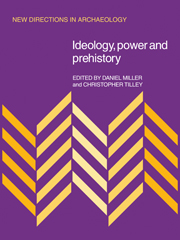Book contents
- Frontmatter
- Contents
- List of contributors
- Preface
- Part one Theoretical perspectives
- Part two Ideology and Power in the Present and Historical Past
- 2 Endo ceramics and power strategies
- 3 Interpreting ideology in historical archaeology: The William Paca Garden in Annapolis, Maryland
- 4 Modernism and suburbia as material ideology
- Part three Ideology and Power in Prehistory
- Part four Conclusions
- Index
3 - Interpreting ideology in historical archaeology: The William Paca Garden in Annapolis, Maryland
Published online by Cambridge University Press: 05 March 2012
- Frontmatter
- Contents
- List of contributors
- Preface
- Part one Theoretical perspectives
- Part two Ideology and Power in the Present and Historical Past
- 2 Endo ceramics and power strategies
- 3 Interpreting ideology in historical archaeology: The William Paca Garden in Annapolis, Maryland
- 4 Modernism and suburbia as material ideology
- Part three Ideology and Power in Prehistory
- Part four Conclusions
- Index
Summary
This chapter focuses on the manner in which ideologically informed representations serve to naturalise the arbitrary nature of the social order. The construction of an eighteenth-century garden is shown to employ a number of means towards this aim. Through the use of classical quotations and the development of a concept of precedence with juridical associations, the garden presents a particular rationalisation of time, which also denies its own transient nature. Its geometry and optics exemplified in its use of perspective, serve towards a controlled rationalisation of space. Overall the garden not only acts as representation but also works as an instrument for the close experimental observation and control of nature. The garden and the segmented and ordered form of Georgian architecture can be related to the contradictions of a society proclaiming freedom and independence but maintaining a system of slavery. The deliberately planned wilderness garden exemplifies such contradictions.
The eighteenth century in Tidewater Virginia and Maryland is today the subject of intensive, rigorous, and multidisciplinary research. There are few areas in the United States where there is more work done by creative people using materials from the past. Historians, architectural historians, folklorists, and historical archaeologists are all producing studies which offer the first new ideas on Chesapeake society since the turn of the century and which are giving the area an historical importance rivalling that long claimed for New England. The Chesapeake is being endowed with a deeper historical identity.
- Type
- Chapter
- Information
- Ideology, Power and Prehistory , pp. 25 - 36Publisher: Cambridge University PressPrint publication year: 1984
- 135
- Cited by



